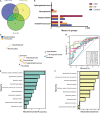Intestinal Microbiota in Colorectal Adenoma-Carcinoma Sequence
- PMID: 35935780
- PMCID: PMC9348271
- DOI: 10.3389/fmed.2022.888340
Intestinal Microbiota in Colorectal Adenoma-Carcinoma Sequence
Abstract
Background: Most colorectal cancer (CRC) cases are sporadic and develop along the adenoma-carcinoma sequence. Intestinal microbial dysbiosis is involved in the development of colorectal cancer. However, there are still no absolute markers predicting the progression from adenoma to carcinoma. This study aimed to investigate the characteristics of intestinal microbiota in patients with colorectal adenoma and carcinoma and its correlations with clinical characteristics.
Methods: Fecal samples were collected from 154 patients with CRC, 20 patients with colorectal adenoma (AD) and 199 healthy controls. To analyze the differences in the intestinal microbiota, 16S rRNA gene sequencing was conducted.
Results: At the genus level, there were four significantly different genera among the three groups, namely Acidaminococcus, Alloprevotella, Mycoplasma, and Sphingobacterium, while Acidaminococcus significantly decreased with the order of Control-AD-CRC (P < 0.05). In addition, Parvimonas, Peptostreptococcus, Prevotella, Butyricimonas, Alistipes, and Odoribacter were the key genera in the network of colorectal adenoma/carcinoma-associated bacteria. The top 10 most important species, including Butyricimonas synergistica, Agrobacterium larrymoorei, Bacteroides plebeius, Lachnospiraceae bacterium feline oral taxon 001, Clostridium scindens, Prevotella heparinolytica, bacterium LD2013, Streptococcus mutans, Lachnospiraceae bacterium 19gly4, and Eubacterium hallii, showed the best performance in distinguishing AD from CRC (AUC = 85.54%, 95% CI: 78.83-92.25%). The clinicopathologic features, including age, gender, tumor location, differentiation degree, and TNM stage, were identified to be closely linked to the intestinal microbiome in CRC.
Conclusion: Several intestinal bacteria changed along the adenoma-carcinoma sequence and might be the potential markers for the diagnosis and treatment of colorectal adenoma/carcinoma. Intestinal microbiota characteristics in CRC should account for the host factors.
Keywords: 16S rRNA; adenoma-carcinoma sequence; colorectal adenoma; colorectal cancer; intestinal microbiota.
Copyright © 2022 Hua, Sun, He, Chen, Teng and Lu.
Conflict of interest statement
The authors declare that the research was conducted in the absence of any commercial or financial relationships that could be construed as a potential conflict of interest.
Figures





Similar articles
-
Correlations between Intestinal Microbiota and Clinical Characteristics in Colorectal Adenoma/Carcinoma.Biomed Res Int. 2022 Jul 28;2022:3140070. doi: 10.1155/2022/3140070. eCollection 2022. Biomed Res Int. 2022. Retraction in: Biomed Res Int. 2023 Dec 29;2023:9810254. doi: 10.1155/2023/9810254. PMID: 35937408 Free PMC article. Retracted.
-
Gut microbiota alterations in colorectal adenoma-carcinoma sequence based on 16S rRNA gene sequencing: A systematic review and meta-analysis.Microb Pathog. 2024 Oct;195:106889. doi: 10.1016/j.micpath.2024.106889. Epub 2024 Aug 26. Microb Pathog. 2024. PMID: 39197689
-
Comparison of human gut microbiota in control subjects and patients with colorectal carcinoma in adenoma: Terminal restriction fragment length polymorphism and next-generation sequencing analyses.Oncol Rep. 2016 Jan;35(1):325-33. doi: 10.3892/or.2015.4398. Epub 2015 Nov 4. Oncol Rep. 2016. PMID: 26549775
-
Changes in gut microbiota and plasma inflammatory factors across the stages of colorectal tumorigenesis: a case-control study.BMC Microbiol. 2018 Aug 29;18(1):92. doi: 10.1186/s12866-018-1232-6. BMC Microbiol. 2018. PMID: 30157754 Free PMC article.
-
Gut Microbial and Associated Metabolite Markers for Colorectal Cancer Diagnosis.Microorganisms. 2023 Aug 8;11(8):2037. doi: 10.3390/microorganisms11082037. Microorganisms. 2023. PMID: 37630597 Free PMC article. Review.
Cited by
-
The Possible Preventative Role of Lactate- and Butyrate-Producing Bacteria in Colorectal Carcinogenesis.Gut Liver. 2024 Jul 15;18(4):654-666. doi: 10.5009/gnl230385. Epub 2023 Nov 30. Gut Liver. 2024. PMID: 38030382 Free PMC article.
-
Gut Microbiome-Colorectal Cancer Relationship.Microorganisms. 2024 Feb 27;12(3):484. doi: 10.3390/microorganisms12030484. Microorganisms. 2024. PMID: 38543535 Free PMC article. Review.
-
Identification of colorectal cancer progression-associated intestinal microbiome and predictive signature construction.J Transl Med. 2023 Jun 8;21(1):373. doi: 10.1186/s12967-023-04119-1. J Transl Med. 2023. PMID: 37291572 Free PMC article.
-
Impact of gut microbiota and its metabolites on immunometabolism in colorectal cancer.Immunometabolism (Cobham). 2024 Nov 28;6(4):e00050. doi: 10.1097/IN9.0000000000000050. eCollection 2024 Oct. Immunometabolism (Cobham). 2024. PMID: 39624362 Free PMC article. Review.
-
Genetic heterogeneity of colorectal cancer and the microbiome.World J Gastrointest Oncol. 2023 Mar 15;15(3):443-463. doi: 10.4251/wjgo.v15.i3.443. World J Gastrointest Oncol. 2023. PMID: 37009315 Free PMC article. Review.
References
LinkOut - more resources
Full Text Sources

